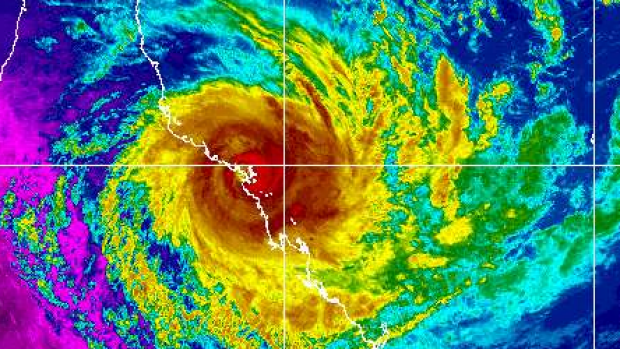Waves recorded at the Queensland town of Mackay are reaching record heights as tropical Cyclone Debbie whips up ferocious seas.
Queensland Government monitoring found waves more than eight metres in height had been recorded early this morning.
The waves will likely be the third highest waves ever recorded at this location.
The highest wave of 10 metres was recorded on January 30, 2014 at 7.30pm, while the second highest wave was 9.4 metres on 21 March, 2010.
Until this morning the record for the third highest wave of 8.5 metres was set in 1997, on March 9.
Mackay is about two hours south of Bowen, close to where Cyclone Debbie is expected to make landfall.
A cyclone watch zone remains in place for Mackay residents and extends from Lucinda to St Lawrence.
The Category 4 cyclone is already causing havoc on the Whitsunday Islands and coastal towns including Airlie Beach. Hamilton Island residents have reported winds “like freight trains”.
The Bureau of Meteorology has also warned of heavy rain along the far north and central Queensland coast.
“Abnormally high tides are also expected to occur between at least Lucinda and Mackay as the cyclone approaches the coast,” BOM meteorologist Andrea Peace said.
“Large waves may also develop along the beachfront so coastal inundation is likely and those highest waves will be on the southern side of the cyclone.”
Cyclone Debbie has been declared a "catastrophe" by the Insurance Council of Australia.

Heavy rainfall expected for Sunshine Coast
The fallout from Cyclone Debbie is set to be felt far south of the storm's destructive path.
The Sunshine Coast Local Disaster Management Group says heavy rain, strong wind and possible flash flooding could hit the region from Thursday morning.
Between 200-400mm of rain is possible in hinterland areas over a 24-hour period, with the Mary River catchment expected to receive significant rainfall. Dangerous surf conditions and beach erosion were also expected.
"At this stage we expect Tropical Cyclone Debbie will be downgraded to a rain depression and continue to track south, bringing very heavy rainfall and possible gale force winds," Local Disaster Management Group coordinator Andrew Ryan said.
"It's also likely there will be a storm surge of 500mm, with localised tidal inundation possible on Thursday night."
A bodyboarder has been spotted jumping into raging surf as the eye of the storm passes over Airlie Beach.
The move immediately drew condemnation online and from Nine News presenter Karl Stefanovic, who urged a reporter to "dob in" the man.
"That is not smart and those guys will get into trouble with the back end of that storm," he said.
While conditions were calm in the tourist hotspot at the time, the other side of the eye wall is beginning to hit already.
"That is obviously not a good idea, at all," reporter Jessica Millward said.
"But there is a lot of backpackers in town, Karl. "I can tell you there has been a lot of cyclone parties throughout the evening and this morning. A fair few inebriated people."AME Research, a consulting outfit, has warned clients of the potential impact of the cyclone on coal markets globally.
The Bowen Basin, the largest metallurgical coal production region in the world, lies directly in its path. Queensland open cut coal mines have less ability to absorb heavy rainfall, as most pits still contain water from previous events.
"AME believes this storm may impact several million tonnes of production over the coming weeks," it warned.
With the price of much of this coal trading at over $US150 a tonne, this indicates several hundred million tonnes of potential short-term cost impact.
As Cyclone Debbie gradually moves inland the effects of the system are being felt as far south as Mackay.
(NEWS.com.au,Brisbane Times)



